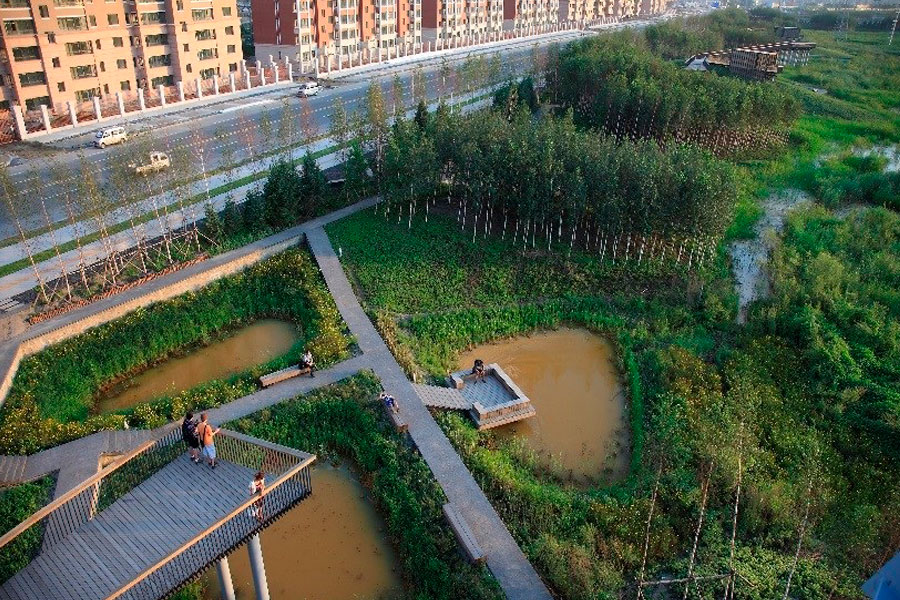Chennai to be developed as a sponge city
Context
-
It is time to adopt innovative water management strategies and transform Chennai into a sponge city to tackle urban flooding.
Key details
- The concept of sponge city is to make urban areas more permeable, have more open spaces store rainwater and allow it to percolate to aquifers.
- The Water Resources Department is mulling over possibility of digging recharge shafts in smaller waterbodies in and around the city.
- These recharge shafts that could be dug up to a depth of 80-90 feet will help replenish water table.
- The smaller waterbodies and temple tanks could be used as structures to store surplus water during intense rain. Water can be drawn, treated and supplied to the city whenever necessary.
About Sponge City
- A sponge city is a new urban construction model for flood management, strengthening ecological infrastructure and drainage systems.
- It can alleviate urban flooding, water resources shortage, and the urban heat island effect and improve the ecological environment and biodiversity by absorbing and capturing rain water and utilizing it to reduce floods.
- Rain water harvested can be repurposed for irrigation and for home use.

Credit: Worldfuturecouncil - It is a form of a sustainable drainage system on an urban scale and beyond.
- Sponge city policies are a set of nature based solutions that use natural landscapes to catch, store and clean water; the concept has been inspired by ancient wisdom of adaptation to climate challenges, particularly in the monsoon world.
What does a Sponge City need in practise?
A sponge cities needs to be abundant with spaces that allow water to seep through them. Instead of only impermeable concrete and asphalt, the city needs more:
- Contiguous open green spaces, interconnected waterways, channels and ponds across neighbourhoods that can naturally detain and filter water as well as foster urban ecosystems, boost bio-diversity and create cultural and recreational opportunities.
- Green roofs that can retain rainwater and naturally filters it before it is recycled or released into the ground.
- Porous design interventions across the city, including construction of bio-swales and bio-retention systems to detain run-off and allow for groundwater infiltration; porous roads and pavements that can safely accommodate car and pedestrian traffic while allowing water to be absorbed, permeate and recharge groundwater; drainage systems that allow trickling of water into the ground or that direct storm water run-off into green spaces for natural absorption
- Water savings and recycling, including extending water recycling particularly of grey water at the building block level, incentivizing consumers to save water through increased tariffs for increase in consumption, raising awareness campaigns, and improved smart monitoring systems to identify leakages and inefficient use of water.
key issues the Sponge City wants to solve
- Less water available in urban and peri-urban areas.
- Polluted water discharged into rivers or the sea.
- Degradation of urban ecosystems and green areas due to sprawling.
- Increase in the intensity and frequency of urban flooding particularly considering predicted increase in extreme weather events due to climate change.
What are the benefits of a Sponge City?
- More clean water for the city
- Cleaner groundwater
- Reduction in flood risk
- Lower burdens on drainage systems, water treatment plant, artificial channels and natural streams.
- Greener, healthier, more enjoyable urban spaces.
- Enriched biodiversity around green open spaces, wetlands, urban gardens and green rooftops
Source: TH & World Future Council
Visit Abhiyan PEDIA (One of the Most Followed / Recommended) for UPSC Revisions: Click Here
IAS Abhiyan is now on Telegram: Click on the Below link to Join our Channels to stay Updated
IAS Abhiyan Official: Click Here to Join
For UPSC Mains Value Edition (Facts, Quotes, Best Practices, Case Studies): Click Here to Join
